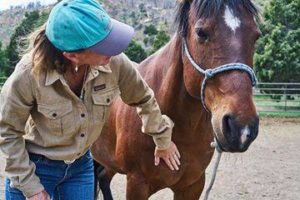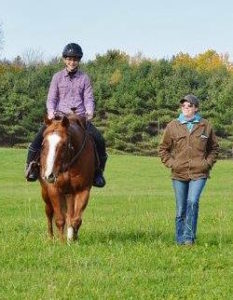
Amy Skinner
Editor’s Note: Amy Skinner is a regular guest columnist and has been a horse gal since age six. She works with owner/operator Jim Thomas as a trainer at Bar T Horsemanship where she rides and teaches English and Western. She has studied at the Royal Andalusian School of Equestrian Art in Spain, with Buck Brannaman, Leslie Desmond, Brent Graef, and many others. Skinner sits on the Best Horse Practices Summit steering committee.
This is Part I of a two-part piece on identifying roadblocks to lightness.
By Amy Skinner
Years ago, I was struggling to get a school horse lighter. He did his job carrying young riders well. But, in the process of training to be lighter, he became confused about how to respond to aids, as his day job involved ignoring many confusing or accidental messages.
My timing wasn’t great and his habit of hanging on the lead rope, for example, was well-established. I had a teacher help me and I watched in awe as within a few minutes, this dull pony brightened up, became more aware and bright in his eye, and responded to her with total lightness.
 She handed me the lead rope back and said, “he just wasn’t clear on a few things.” I felt this sense of magic in my hands now, as if all our problems together were fixed and all I had to do was maintain that perfection she created. Unfortunately, within minutes, he was back to hanging on the lead and I was back to being frustrated.
She handed me the lead rope back and said, “he just wasn’t clear on a few things.” I felt this sense of magic in my hands now, as if all our problems together were fixed and all I had to do was maintain that perfection she created. Unfortunately, within minutes, he was back to hanging on the lead and I was back to being frustrated.
So what happens between those moments: when the skilled horseman or woman with good timing handles the horse and then hands it off to the student? I’ve put together a list of elements that can dull or confuse horses and added tips for how to encourage lightness in all areas of horse work.
Petting:
How you pet your horse, believe it or not, makes a huge difference in how he understands interactions with you on the ground or in the saddle.
- Is he pushing on you to get more scratches? If your horse pushes on you, or worse, moves you while getting pets, then he may also push through your leg, your bridle, your lead rope.
- Does your horse avoid your touch and leave? You want to teach your horse to seek out your aids. Those aids can be anything from your touch with a hand to your leg or rein. If the horse avoids these aids, he gets released without responding correctly. He learns to do the wrong thing.

Amy Skinner
Petting, to me, should be done in a way that encourages softness, relaxation, and respect. I don’t take my hand away when a horse pushes or avoids, but I release my hand for the horse softening to my touch. When you pet and when you stop petting is important.
Feeding time:
Again, if your horse is pushing on you to receive food, this will create problems in the saddle. My horses don’t get grain until their ears are up and their faces are soft. I don’t reward grumpy faces or threatening ears. They also don’t get to push me out of the way as I set their hay down. I want calm, relaxed, and respectful horses at feeding time. I will add that it isn’t fair to expect horses to be calm about feeding time if they’re waiting hours between feedings, especially if it’s cold.
Leading:
We tend to absent-mindedly grab our horses and lead them to the barn without paying attention to the quality of our leading. The way your horse leads is the way he will ride. Leading is a crucial part of my horses’ training.
- Does the horse drag on the lead rope?
- Does he rush ahead?
A horse that leads well will likely ride well. Leading well doesn’t just mean he follows you, it means he responds to the lead rope, where and how it asks him to be. He should be light on the rope, not rushing ahead or dragging behind. He should lead equally well from both sides. He should respond to you asking him to step forward, stop, back up, or move to the side without interfering with the path you walk. He should be focused on you.
 Leslie Desmond once told me a halter broke horse is one who’s lead rope you can stick in your belt and go about your chores without him getting in your way. This horse is a joy to handle.
Leslie Desmond once told me a halter broke horse is one who’s lead rope you can stick in your belt and go about your chores without him getting in your way. This horse is a joy to handle.
Tying:
This element relates to leading.
- Does your horse pull slack out of his lead rope while he stands tied?
- Does he peddle backward and hang on the rope?
These are symptoms of a poorly halter-broke horse, or one who is not clear on the meaning of the lead rope. It’s also likely that this horse will not respond correctly to rein aids. I don’t tie horses until they respond properly to the lead rope, and when I do tie them, I make sure they can’t take slack from the rope or worse, get away.
Thanks Amy, spot on as usual. Horses who push, pull, or drag you around are annoying at best and dangerous at worst. Everything you see or feel with the horse from the ground is exactly what you’ll get from the saddle. Looking forward to Part II of your article!!
What a great article, thanks for addressing these base line communicatuins with horses,most riders don’t realize that this is where good communication, feeling and being in tune with your horse starts…..well said Amy
Great content. Well written. I am working on this with a new horse now and couldn’t have been more timely.